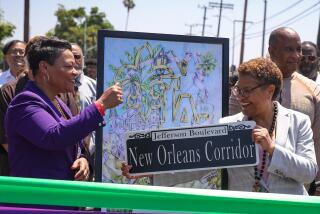Documenting African Americans’ ‘Odyssey’
- Share via
WASHINGTON — In his lyrical and rich volume “There Is a River” (Harcourt Brace, 1993), Vincent Harding described African American history as a flowing body of water. The Library of Congress’ new exhibit, “The African American Odyssey,” might also remind you of a river--a very broad one moving rapidly from the transatlantic slave trade to the 1960s civil rights movement.
With 250 documents, photographs, prints and other items, the show spans the library’s three buildings and is a strong sampler of its vast collection of materials on black history--millions of pieces, the largest of its kind in the world.
This is a show cultivated with a librarian’s sensibility. It best serves those of us who can lose ourselves in viewing centuries-old documents and be thrilled by the sight of the original paper and ink.
There is a yellowing copy of “The Confessions of Nat Turner, the Leader of the Late Insurrection in Southampton, Va.,” an account by the man whose insurrection resulted in the deaths of 60 whites and sent alarm through the slaveholding states. The mutiny aboard the Amistad slave ship--subject of a recent film--is documented here with Supreme Court papers, a lithograph and an affidavit taken from Cinque, the African leader of the rebellion. Looming on one wall is the actual NAACP flag immortalized in an early 20th century photograph. It reads: “A Man Was Lynched Today,” and sits opposite chilling maps documenting the thousands of people lynched and burned in the United States from 1889 to 1922.
But the strength of the show is also its weakness. Because it is so sweeping, compared with more specific black history exhibits the library has mounted in the past, those already acquainted with the field may find little new information here. And young audiences might be turned off by the traditional presentation: no interaction, no buttons to push or levers to pull.
There is a certain restraint--no images, for example, of lynchings or other violence. Library officials insist that this tone was not influenced by last year’s protest by some black staffers against a photo exhibit on slave life that was yanked the same day it was mounted.
Perhaps the most significant aspect of “The African American Odyssey” is on view on the Internet, at https://www.loc.gov, with more materials being added every day. Debra Newman Ham, a professor of history at Morgan State University and the former specialist in African American history for the Library of Congress, is curator of the exhibit and editor of the show’s 165-page catalog.
She said that while visitors to the exhibit will be able to see only a page or two of a displayed document, visitors to the Web site will be able to read entire texts.
Ham expects the site will be in high demand. She said that the library’s current site related to African American history, set up in 1994 in connection with her comprehensive 1993 Library of Congress resource guide, “The African American Mosaic,” is one of the most popular of the library’s electronic exhibitions. Print research technology has not fared as well--the comprehensive guide on which this show is based is virtually out of print or, as the library says, “is in print in limited quantities.”
*
* “The African American Odyssey” is on view at the Library of Congress through May 2, 10 a.m. to 5 p.m. Monday through Saturday; the library is closed on federal holidays. Admission is free.
More to Read
The biggest entertainment stories
Get our big stories about Hollywood, film, television, music, arts, culture and more right in your inbox as soon as they publish.
You may occasionally receive promotional content from the Los Angeles Times.










